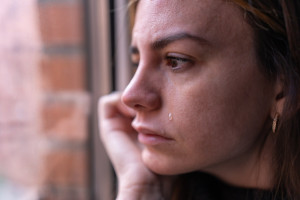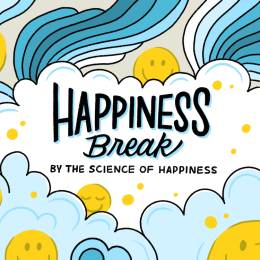I like to warn people who don’t know me well that I can be a bit of a crier. I often cry over sad movies, shedding big tears with abandon, as well as obviously sad events like funerals.

But the crying doesn’t stop there: I’ll weep at weddings and graduations, when reading about extraordinary acts of kindness, or while experiencing something amazing, like an eclipse. My tears can run the gamut, expressing joy, sorrow, empathy, or wonder.
Not everyone cries as much as I do, for sure, but it’s still a ubiquitous and very human experience. Yet, until recently, scientists didn’t really know why we cry or what it does for us (or to us), mostly relying on assumptions based on psychiatric or philosophical theories.
However, the science of crying has grown over the past two decades, uncovering some interesting theories about the role of weeping in our lives. While crying in excess can be a sign of depression, it also helps people cope with emotional overwhelm, and it can draw support from caring others, helping connect us to one another and create a more compassionate society.
The origins of crying
From the time babies are born, they communicate their needs to those around them via crying, eliciting the care they depend on to survive. Yet scientists believe that only human babies shed tears and that crying may have evolved to help protect helpless babies against predators by providing a non-vocal sign of distress.
As we age, we continue to cry now and then, but often for reasons other than discomfort or pain alone. We cry when we’re feeling sad or experiencing loss, with tears emphasizing our sorrow for ourselves and others. We may cry when we’re happy or moved—like at weddings, graduations, or award ceremonies. Or we can cry in frustration or helplessness (like when experiencing a computer crash), or when witnessing awe-inspiring events (like an extreme altruistic act of kindness).
Ad Vingerhoets of Tilburg University, The Netherlands, has studied crying for decades. In a 2022 TED talk, he explains that people at any age may cry when experiencing loss or powerlessness. However, as people get older they’re more likely to be moved to tears out of nostalgia, awe, or empathy, or in response to witnessing a moral act. It’s this capacity in adults to cry in response to goodness or kindness, he says, that suggests crying becomes more prosocial as we age.
“Once we are adults, tears become . . . a signal to ourselves, to remind ourselves of our ultra-social nature and to stress the importance of good social and moral functioning,” he says.
While this might explain why we cry, though, it doesn’t tell us what crying accomplishes, exactly. In fact, it turns out that crying may have some nice intrapersonal and interpersonal benefits for those who experience it.
How crying helps soothe us
I know that when I cry, I feel a kind of release of tension or catharsis that makes me feel better afterward. I’m not alone. Many people find crying to be self-soothing when they experience intense emotion, perhaps because crying releases feel-good hormones, like endorphins and oxytocin.
Crying doesn’t necessarily improve health or resilience, though. In one study, Vingerhoets and his colleagues exposed people to very sad movies (or non-emotive movies) and then had them undergo a stress test (by putting their hand in ice-cold water) to see if crying affected how well people tolerated the discomfort of the test and recovered afterward. It didn’t. There were no differences between people who cried or who didn’t cry in their response to the stress test.
However, there was a difference in their physiology while watching the movie. Those who cried during the sad movie had a more stable respiration rate than non-criers, and their elevated heart rate returned to normal more quickly. This suggests crying may help people regain physiological balance more quickly when they’re sad.
While crying can be soothing, not everyone benefits equally from crying. Women who cry more frequently (like me!) report feeling better after a good cry, while those who cry less feel better holding back their tears. Women are generally more apt to cry than men and may get more relief from crying than men, especially if they live in a country that values emotional expression and doesn’t adhere to strict, traditional gender roles. Yet men also report benefits of crying and may feel freer to cry under certain circumstances, like at funerals, where weeping is often seen as the norm.
Cultural expectations can play a role in crying’s benefits, too. For example, in countries that generally value group harmony over individual needs, people don’t approve of crying as much as those in Westernized countries, where individual expression is more valued. Potential disapproval could easily make people wary of crying, foiling potential catharsis.
Crying when alone doesn’t seem to help much with physical pain relief, either, as one study found. People who were induced to feel sad (watching a sad video) and cried fared no better with pain from electric shocks or from the cold-water test than those who didn’t cry when sad.
While studies find mixed benefits for crying when one is alone, there is ample evidence to show that crying around others can provide social benefits, helping to foster warmer, more caring interactions.
The interpersonal benefits of crying
When we cry, we are sending out a distress call of sorts to those around us, letting them know we’re overwhelmed. Tears naturally stimulate care and empathy in others, making them feel more connected to us and wanting to help. Even strangers or outsiders who cry seem warmer and closer to us, invoking our sense of care for them and encouraging our altruistic tendencies.
Shedding tears can also make other people see us as less threatening, making it easier to like us. Crying can help during interpersonal transgressions, too, as it signifys that someone is truly remorseful. For example, in one study, people who saw someone crying while offering a public apology had greater empathy for the person, thought better of them, and felt more satisfied by the apology. They also believed the tearful apologizer would be less likely to offend again. Similarly, parents who see transgressing children cry are more likely to forgive and trust them to do better next time.
Crying may earn you more trust from others in other situations, too, as one study found. People in a lab who played a “trust game”—which involves trusting a stranger to reciprocate generosity—were more apt to share resources with a potential trustee if that person’s face showed tears versus no tears. However, in the same study, when people played a “dictator game”—where one person makes a take-it-or-leave-it offer to another player—they showed no preference for teary faces. The authors conclude that crying may make someone appear more trustworthy, but that won’t necessarily induce the person witnessing the crying to be altruistic.
While a lot of research on crying has been done in Western countries, one large-scale study was done with over 7,000 people from 41 countries, giving a more universal look at crying’s purpose. Researchers showed participants faces with or without digitally added tears and asked how they felt about the person pictured. In all cases, faces with tears elicited a stronger intention to offer comfort to the person than faces without tears. People felt warmer, more empathic toward, and more connected to someone who appeared to be crying than someone who wasn’t, regardless of their gender, country of origin, or other factors involved.
Clearly, crying affects people in positive ways, though individual factors influence the strength of those effects. In the international study above, more empathic people tended to feel the warm, caring effects more strongly than those who were less empathic. Group membership mattered, too: We tend to view crying people from our own groups more warmly than weepy “outsiders.” Yet, even in those latter cases, tears still affected people, pulling on their heartstrings.
Context does matter when it comes to how people respond to crying, though—as does intent. A man bawling at work may be viewed less positively than a man crying at a funeral, for example, and may elicit less sympathy. Likewise, if someone thinks you’re shedding tears in order to gain something from them—to manipulate them in some way—they’re less likely to feel warmly toward you or want to help. And, while crying may make people feel better about you in many ways, it can make people think of you as less competent in some cases, especially if your reasons for crying are ambiguous.
Still, according to the studies to date, your reputation won’t take a hit if you cry. And, overall, the research is pretty clear that crying is generally good for social bonding. Not only will you likely feel better and draw support from others, you will make it safer for them to do the same. That could begin a more general cycle of kindness and care—and so create a more compassionate society for all.









Comments